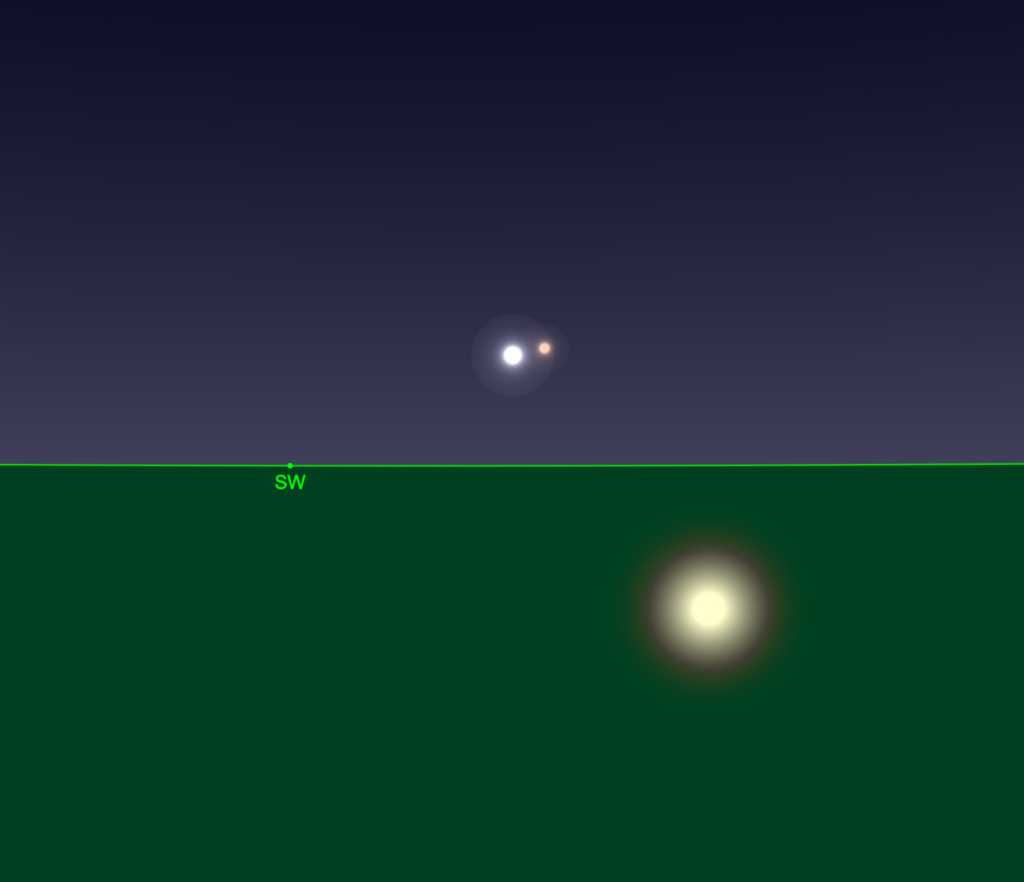Sky Report: December 26 – January 1, 2022

December 29, 40 minutes after sunset. The horizon is translucent so you can see the sun. Venus and Mercury are 6° above the horizon and are separated by only 1¾°.
I focus on the moon and planets because that’s where most of the action is; they make it interesting to follow motions and changes in the sky. This week, but not next, all 5 naked-eye planets plus the two telescopic ones are visible in the evening sky, and that’s highly unusual. Here’s where they are.
The brightest two are brilliant. Jupiter is halfway up the southern sky in twilight (how soon can you see it after sunset?) and it sets around midnight. On the 29th Jupiter is 7° to the right of the first quarter moon. It has a soft-white color.
Mars is almost as bright as Jupiter and it’s distinctly yellow-orange in color. It’s a third of the way up the eastern sky in twilight and due south around 10:30. Mars was closest to earth almost a month ago but it remains quite bright well into the new year.
Saturn has been conspicuous for months but it’s slowly slipping behind the sun and it’s lower in the southwest each evening. Look for it in early twilight less than a third of the way up the southwest sky. On the 26th its 5° to the right of the moon and you’ll see both together in most binoculars.
Uranus is between Mars and Jupiter, in Aries, and Neptune is 8° to the right of Jupiter in easternmost Aquarius. You’ll need at least binoculars and finder charts to see them; I recommend an app like SkySafari or the equivalent.
Most interesting is what’s happening very low in the southwest about 40 minutes after sunset. There you’ll see both Mercury and Venus. Venus is brilliant and it will guide you to Mercury, which is only 1/40th as bright. On the 26th Mercury is 3° straight above Venus, but Venus is moving eastward against the stars (and against Mercury) and they draw closer night-by-night. On the 29th Mercury is less than 2° straight to the right of Venus in a nice conjunction. You’ll need binoculars – which every stargazer needs – and a dead flat southwestern horizon. The time is critical to let the sky get somewhat dark but while the two planets still have some altitude; at 40 minutes after sunset they’re only 6° above the geometric horizon. Good luck!
Next week Mercury drops out of sight, moving between the earth and sun, while Venus continues to climb higher each night and to become easier to see against a darker sky and for longer. This coming spring it’ll dominate the western sky, passing very close to Saturn in a few weeks and to Jupiter in 3 months and to Mars this coming summer. Stay tuned.
Our new year begins on January 1, but it doesn’t have to begin then and it didn’t always. It was common to begin the year in March – which makes SEPTember the 7th month, and so on. Google can provide answers, some of it conflicting; search for “why is January the first month” or similar.
Stellar Vista Observatory provides portable telescopes and tripod mounted binocular kits on loan for free to residents and visitors in Kane County. Enhance your enjoyment of the night sky! For details or to request a loan, visit https://stellarvistaobservatory.org/discover-the-night-sky/ or drop in to the Kane County Office of Tourism.
The Sky Report is presented as a public service by the Stellar Vista Observatory, a nonprofit organization based in Kanab, Utah, which provides opportunities for people to observe, appreciate, and comprehend our starry night sky. Additional information is at www.stellarvistaobservatory.org. Send questions and comments to John@StargazingAdventures.org.






Comments are closed.